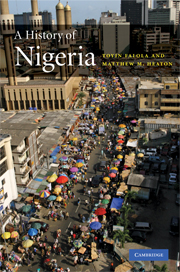Book contents
- Frontmatter
- Contents
- List of illustrations
- List of maps
- Acknowledgments
- Chronology
- Notable people in Nigerian history
- List of abbreviations
- Glossary
- Map 1 Major cities and ethnic groups in present-day Nigeria
- Introduction
- 1 Early states and societies, 9000 BCE – 1500 CE
- 2 Slavery, state, and society, c. 1500 – c. 1800
- 3 Political and economic transformations in the nineteenth century
- 4 Transition to British colonial rule, 1850 – 1903
- 5 Colonial society to 1929
- 6 Nationalist movements and independence, 1929 – 1960
- 7 Instability and civil war, 1960 – 1970
- 8 Oil, state, and society, 1970 – 1983
- 9 Civil society and democratic transition, 1984 – 2007
- 10 Nigeria and Nigerians in world history
- Concluding remarks: corruption, anti-corruption, and the 2007 elections
- Notes
- Selected bibliography
- Index
Concluding remarks: corruption, anti-corruption, and the 2007 elections
Published online by Cambridge University Press: 05 June 2012
- Frontmatter
- Contents
- List of illustrations
- List of maps
- Acknowledgments
- Chronology
- Notable people in Nigerian history
- List of abbreviations
- Glossary
- Map 1 Major cities and ethnic groups in present-day Nigeria
- Introduction
- 1 Early states and societies, 9000 BCE – 1500 CE
- 2 Slavery, state, and society, c. 1500 – c. 1800
- 3 Political and economic transformations in the nineteenth century
- 4 Transition to British colonial rule, 1850 – 1903
- 5 Colonial society to 1929
- 6 Nationalist movements and independence, 1929 – 1960
- 7 Instability and civil war, 1960 – 1970
- 8 Oil, state, and society, 1970 – 1983
- 9 Civil society and democratic transition, 1984 – 2007
- 10 Nigeria and Nigerians in world history
- Concluding remarks: corruption, anti-corruption, and the 2007 elections
- Notes
- Selected bibliography
- Index
Summary
INTRODUCTION
On May 29, 2007, Olusegun Obasanjo stepped down as president of Nigeria, having served the maximum two terms allowed under the constitution. Alhaji Umaru Yar'Adua, the brother of Obasanjo's deputy head of state in the 1970s, was inaugurated as the new president of Nigeria, marking the first time in Nigeria's history that power was transferred from one civilian ruler to another. The PDP extended its domination of political offices throughout the country, controlling both federal houses as well as the governorships and state legislatures in twenty-eight of the thirty-six states of the federation.
The 2007 elections highlighted several of the internal contradictions of Nigerian politics as they relate to the issue of political corruption. On the surface, the transfer of power to Yar'Adua served as an indication of the potential for stability and longevity of democratic, civilian rule in the Fourth Republic. The lead-up to the elections saw an unprecedented crackdown on corruption in the country. The federal anti-corruption body, the Economic and Financial Crimes Commission, along with various state legislatures, brought charges against many powerful politicians. The elections, which took place for local and state offices on April 14 and for federal offices on April 21, were conducted with a minimum of violence. All these factors are encouraging, and they illustrate the extent to which the Fourth Republic has been able to accomplish things that other civilian regimes have not.
- Type
- Chapter
- Information
- A History of Nigeria , pp. 271 - 279Publisher: Cambridge University PressPrint publication year: 2008



